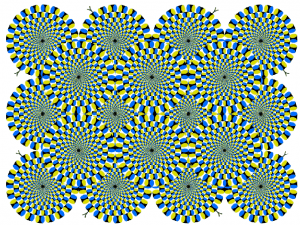The wagon-wheel effect (alternatively, stagecoach-wheel effect, stroboscopic effect) is an optical illusion in which a spoked wheelappears to rotate differently from its true rotation. The wheel can appear to rotate more slowly than the true rotation, it can appear stationary, or it can appear to rotate in the opposite direction from the true rotation. This last form of the effect is sometimes called thereverse rotation effect.
The wagon-wheel effect is most often seen in film or television depictions of stagecoaches or wagons in Western movies, although recordings of any regularly spoked wheel will show it, such as helicopter rotors and aircraft propellers. In these recorded media, the effect is a result of temporal aliasing.[1] It can also commonly be seen when a rotating wheel is illuminated by flickering light. These forms of the effect are known as stroboscopic effects: the original smooth rotation of the wheel is visible only intermittently. A version of the wagon-wheel effect can also be seen under continuous illumination.
Rushton (1967[5]) observed the wagon-wheel effect under continuous illumination while humming. The humming vibrates the eyes in their sockets, effectively creating stroboscopic conditions within the eye. By humming at a frequency of a multiple of the rotation frequency, he was able to stop the rotation. By humming at slightly higher and lower frequencies, he was able to make the rotation reverse slowly and to make the rotation go slowly in the direction of rotation. A similar stroboscopic effect is now commonly observed by people eating crunchy foods, such as carrots, while watching TV: the image appears to shimmer.[6] The crunching vibrates the eyes at a multiple of the frame rate of the TV. Besides vibrations of the eyes, the effect can be produced by observing wheels via a vibrating mirror. Rear-view mirrors in vibrating cars can produce the effect.
Truly continuous illumination
The first to observe the wagon-wheel effect under truly continuous illumination (such as from the sun) was Schouten (1967[7]). He distinguished three forms of subjective stroboscopy which he called alpha, beta, and gamma: Alpha stroboscopy occurs at 8–12 cycles per second; the wheel appears to become stationary, although “some sectors [spokes] look as though they are performing a hurdle race over the standing ones” (p. 48). Beta stroboscopy occurs at 30–35 cycles per second: “The distinctness of the pattern has all but disappeared. At times a definite counterrotation is seen of a grayish striped pattern” (pp. 48–49). Gamma stroboscopy occurs at 40–100 cycles per second: “The disk appears almost uniform except that at all sector frequencies a standing grayish pattern is seen … in a quivery sort of standstill” (pp. 49–50). Schouten interpreted beta stroboscopy, reversed rotation, as consistent with there being Reichardt detectors in the human visual system for encoding motion. Because the spoked wheel patterns he used (radial gratings) are regular, they can strongly stimulate detectors for the true rotation, but also weakly stimulate detectors for the reverse rotation.
There are two broad theories for the wagon-wheel effect under truly continuous illumination. The first is that human visual perception takes a series of still frames of the visual scene and that movement is perceived much like a movie. The second is Schouten’s theory: that moving images are processed by visual detectors sensitive to the true motion and also by detectors sensitive to opposite motion from temporal aliasing. There is evidence for both theories, but the weight of evidence favours the latter.
Discrete frames theory
Purves, Paydarfar, and Andrews (1996[8]) proposed the discrete-frames theory. One piece of evidence for this theory comes from Dubois and VanRullen (2011[9]). They reviewed experiences of users of LSD who often report that under the influence of the drug a moving object is seen trailing a series of still images behind it. They asked such users to match their drug experiences with movies simulating such trailing images viewed when not under the drug. They found that users selected movies around 15–20 Hz. This is between Schouten’s alpha and beta rates.
Other evidence for the theory is reviewed next.
Temporal aliasing theory
Kline, Holcombe, and Eagleman (2004[10]) confirmed the observation of reversed rotation with regularly spaced dots on a rotating drum. They called this “illusory motion reversal”. They showed that these occurred only after a long time of viewing the rotating display (from about 30 seconds to as long as 10 minutes for some observers). They also showed that the incidences of reversed rotation were independent in different parts of the visual field. This is inconsistent with discrete frames covering the entire visual scene. Kline, Holcombe, and Eagleman (2006[11]) also showed that reversed rotation of a radial grating in one part of the visual field was independent of superimposed orthogonal motion in the same part of the visual field. The orthogonal motion was of a circular grating contracting so as to have the same temporal frequency as the radial grating. This is inconsistent with discrete frames covering local parts of visual scene. Kline et al. concluded that the reverse rotations were consistent with Reichardt detectors for the reverse direction of rotation becoming sufficiently active to dominate perception of the true rotation in a form of rivalry. The long time required to see the reverse rotation suggests that neural adaptation of the detectors responding to the true rotation has to occur before the weakly stimulated reverse-rotation detectors can contribute to perception.
Some small doubts about the results of Kline et al. (2004) sustain adherents of the discrete-frame theory. These doubts include Kline et al.’s finding in some observers more instances of simultaneous reversals from different parts of the visual field than would be expected by chance, and finding in some observers differences in the distribution of the durations of reversals from that expected by a pure rivalry process (Rojas, Carmona-Fontaine, López-Calderón, & Aboitiz, 2006[12]).
In 2008, Kline and Eagleman demonstrated that illusory reversals of two spatially overlapping motions could be perceived separately, providing further evidence that illusory motion reversal is not caused by temporal sampling.[13] They also showed that illusory motion reversal occurs with non-uniform and non-periodic stimuli (for example, a spinning belt of sandpaper), which also cannot be compatible with discrete sampling. Kline and Eagleman proposed instead that the effect results from a “motion during-effect”, meaning that a motion after-effect becomes superimposed on the real motion.
Dangers
Because of the illusion this can give to moving machinery, it is advised that single-phase lighting be avoided in workshops and factories. For example, a factory that is lit from a single-phase supply with basic fluorescent lighting will have a flicker of twice the mains frequency, either at 100 or 120 Hz (depending on country); thus, any machinery rotating at multiples of this frequency may appear to not be turning. Seeing that the most common types of AC motors are locked to the mains frequency, this can pose a considerable hazard to operators of lathes and other rotating equipment. Solutions include deploying the lighting over a full 3-phase supply, or by using high-frequency controllers that drive the lights at safer frequencies.[14] Traditional incandescent light bulbs, which employ filaments that glow continuously, offer another option as well, albeit at the expense of increased power consumption. Smaller incandescent lights can be used as task lighting on equipment to help combat this effect to avoid the cost of operating larger quantities of incandescent lighting in a workshop environment.



